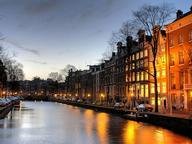Quiz Answer Key and Fun Facts
1. Amsterdam, originally called Aemstelland, was once a small fishing village that began to grow considerably in 1275 when Floris V did what?
2. Over the course of the 13th century, Amsterdam became an important trading city with the Hanseatic League. The city continued to grow in the next century because of religious pilgrims that came to the city after the Miracle of Amsterdam. What is another name for the Miracle of Amsterdam?
3. Amidst the Reformation in the 16th century, an Anabaptist rebellion in which German city led to the persecution of that group in Amsterdam?
4. Which of the following is true regarding Amsterdam's position on religion following the Dutch Rebellion and the Eighty Years War in the mid 17th century?
5. Founded in 1602 in Amsterdam, which company's rise allowed Amsterdam to become the most financially important city in Europe, if not the world, during the 17th century?
6. Amsterdam's dominance as a financial center began to decline when what struck the city in the 1660s?
7. Pachtersoproer occurred on June 25, 1748. What is Pachtersoproer?
8. On August 4, 1944, Anne Frank and her family's hiding place was exposed and the Franks were arrested. Who revealed their hiding place to the authorities?
9. Which museum, the most visited in the Netherlands, opened in Amsterdam in 1973 and houses such works as "Sunflowers" and "The Potato Eaters"?
10. The assassination in Amsterdam of which man on November 2, 2004 created a period of social unrest in a city known for its tolerance and diversity?
Source: Author
Joepetz
This quiz was reviewed by FunTrivia editor
gtho4 before going online.
Any errors found in FunTrivia content are routinely corrected through our feedback system.
